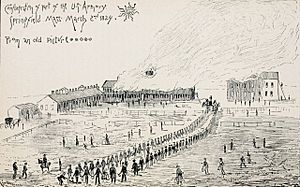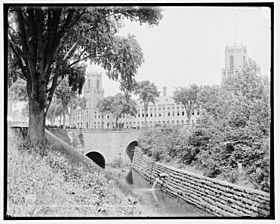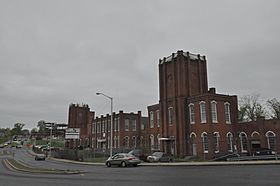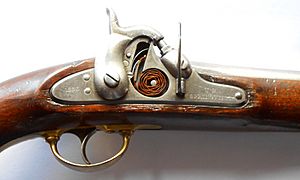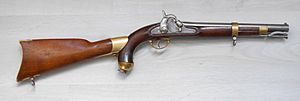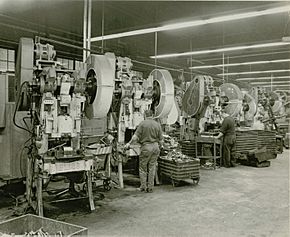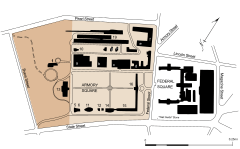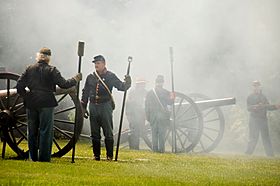Springfield Armory facts for kids
|
Springfield Armory National Historic Site
|
|
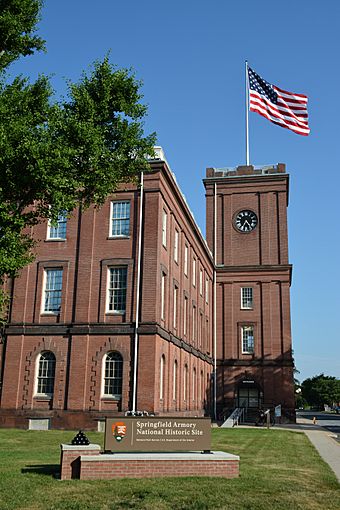
The clocktower of the Main Arsenal building, built in 1847
|
|
| Location | Armory Sq., Springfield, Massachusetts, United States |
|---|---|
| Built | 1778 |
| Architectural style | Greek Revival |
| Website | Springfield Armory National Historic Site |
| NRHP reference No. | 66000898 |
Quick facts for kids Significant dates |
|
| Added to NRHP | October 15, 1966 |
| Designated NHLD | December 19, 1960 |
The Springfield Armory was a very important place in Springfield, Massachusetts. From 1777 to 1968, it was the main factory for making firearms for the United States military. It was the first federal armory and one of the first factories in the U.S. built just for making weapons.
Today, the site is a special place called the Springfield Armory National Historic Site. It is the only national park area in Western Massachusetts. You can see the world's largest collection of old American firearms there.
The Springfield Armory was famous during the American Revolutionary War. It was also where a big event happened during Shays' Rebellion. In the 1800s and 1900s, the Armory became a place for amazing new inventions. These included interchangeable parts, the assembly line way of making things, and modern business ideas like paying people by the hour.
The Armory played a huge role in the American Civil War. It made most of the weapons for the Union army. They made 32 times more firearms than the Confederate army! Historians say that the Armory's ability to make so many weapons helped start the idea of mass production. This led to the Second Industrial Revolution and the assembly lines we know today. The guns made here from 1794 to 1968 are often called "Springfield muskets and rifles".
Contents
How the Armory Started (1777)
Long before the Armory, local soldiers used the high ground in Springfield for training. This was especially true after an attack on Springfield during King Philip's War.
In 1777, during the American Revolutionary War, George Washington chose this spot for an armory. General Henry Knox, his artillery chief, suggested it. Even though Springfield was a small town, it was a great location. It was where three rivers met, including the big Connecticut River. Four main roads also led from there to New York City, Boston, Albany, and Montreal.
Springfield was also safe from ships coming up the river. Just north of the town, there was a waterfall called Enfield Falls. This waterfall was too steep for large ships to pass. This meant Springfield was the first town on the Connecticut River that was safe from naval attacks.
The Armory itself sits on a high hill, like a fortress. It looks over the Connecticut River where it meets the Westfield River. General Knox agreed with Washington that it was "perhaps one of the most proper spots on every account" for an arsenal.
In 1777, American colonists set up "The Arsenal at Springfield." They made cartridges and gun carriages for the war. During the Revolution, the arsenal stored muskets, cannons, and other weapons. They built soldier barracks, shops, and storage buildings. After the war, the Army kept the facility to store weapons for the future. By the 1780s, the Springfield Arsenal was a major place for ammunition and weapons.
Later, as making things became more important, the arsenal grew. It moved to a second area in Springfield where water power was available. The Mill River was dammed to create a lake called Watershops Pond. The main shops were built behind the dam, and a foundry was built below it. This factory was updated and most of the work for Springfield and Garand rifles happened there.
President George Washington chose David Ames to be the first leader of the armory. David's father, Captain John Ames, was a blacksmith who made guns for the Colonial army.
Shays' Rebellion and the Armory (1787)
In 1786 and 1787, a veteran of the American Revolutionary War named Daniel Shays led an armed uprising. He wanted to change the government of Massachusetts. On January 25, 1787, thousands of Shays' followers marched on the Springfield Armory. They hoped to grab its weapons and force the government to change.
That day, the Springfield Armory was defended by state soldiers. They fired grape shot (small metal balls like a shotgun blast) at the rebels. This made the rebels run away. This event was very important because Shays' Rebellion was soon stopped. Some of its leaders were even put on trial for treason.
Shays' Rebellion directly influenced the leaders who wrote the U.S. Constitution in 1787. George Washington said it was why he came out of retirement to help. During the talks about the Constitution, James Madison warned everyone. He said, "the rebellion in Massachusetts is a warning, gentlemen," to encourage a stronger federal government.
Making Weapons (1795–1968)
Early Production Years
In 1793, the National Arsenal held many military items. These included cannons, howitzers, carriages, shot, shells, and powder. It also had muskets, swords, and other supplies. In 1795, the Springfield Armory made the new nation's first musket. It was called the Model 1795 Musket. This gun was much like the French Charleville musket used by the French army during the American Revolution.
Innovations in the 1800s
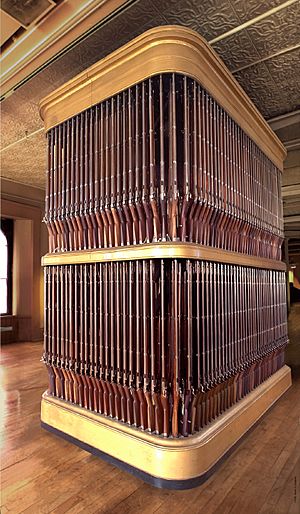
The Armory was key in supplying weapons for the American Army during the War of 1812. In 1814, it made 9,588 new muskets and fixed 5,190 old ones.
Springfield quickly became a national center for new ideas. In 1819, Thomas Blanchard invented a special lathe machine. This machine could make many rifle stocks that were all exactly the same. Blanchard worked at the Armory for five years. His lathe allowed workers to easily make identical shapes. This was a big step for mass production.
In the 1840s, the old flintlock guns were replaced. New guns used a percussion system. This made longarms more reliable and simpler to use.
The Springfield Armory helped grow the Industrial Revolution. The military wanted "interchangeable parts" for firearms. This meant it would be easier to replace broken parts than to fix them. Making truly interchangeable parts needed more machines, better ways to measure, and a division of labor. These were all important parts of the Industrial Revolution. From these ideas, the concept of the assembly line was born.
The Armory also improved how businesses were run. Colonel Roswell Lee, who became superintendent in 1815, brought new ideas. He created a central authority, tracked costs for pay and materials, and made the factory more organized. These business practices are still used today.
In 1843, the poet Henry Wadsworth Longfellow visited the Armory. He wrote his poem "The Arsenal at Springfield." This anti-war poem described the many guns stored there. By then, 1,000,000 guns were stacked vertically in open racks. He wrote, "Like a huge organ, rise the burnished arms."
The Civil War and Beyond
When the Harpers Ferry Armory was destroyed early in the American Civil War, the Springfield Armory was the only government factory making arms. This changed when the Rock Island Arsenal was built in 1862. During this time, production at Springfield grew hugely. In 1860, they made only 9,601 rifles. By 1864, they made 276,200!
These improvements gave the Union a big advantage in the war. They also led to the mass production methods of the Second Industrial Revolution. Historian Merritt Roe Smith compared the early rifle making at Springfield to the later production of the Ford Model T. The Armory's work helped pave the way for modern factory methods.
In 1865, Master Armorer Erskine Allin created the "Allin Conversion." This changed old muzzleloaders into more advanced breech-loading guns. This made the old guns useful for longer. In 1891, the Armory got a new job. It became the army's main lab for creating and testing new small arms.
One special part of the Armory is the fence around it. It was started after the Civil War and finished in 1890. Major James W. Ripley needed a fence but had no money. He asked for old cannons from government storage, some from the Revolutionary War. He sent them to a local factory to be melted down. The factory kept some iron as payment. The rest was made into 9-foot tall spikes shaped like spears. These were then set into a red stone base.
The 1900s and World Wars
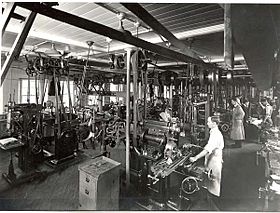
During the Spanish–American War, U.S. troops saw that the Spanish Mauser Model 1893 rifle was better than their own. On August 15, 1900, Springfield Armory finished a new experimental rifle. They thought it was better than the Krag rifle. They made a rifle where the bullets were held inside the stock, protecting them. This was approved for production as the Model 1903. Later, Mauser sued for patent infringement and won money from Springfield.
By the time the United States joined World War I in 1917, about 843,239 Model 1903 rifles had been made. But this was not enough for all the U.S. soldiers. During the war, Springfield Armory made over 265,620 Model 1903 rifles. The War Department also had the M1917 Enfield Rifle made to help. These, plus rifles from the Rock Island Arsenal and those already in use, were enough for the war. During World War I, the Armory also made about 25,000 M1911 pistols before focusing only on the M1903 rifles.
In 1919, John Garand came to Springfield. He worked to create a semi-automatic rifle. For five years, many designs were tried, but none met the army's strict rules. In 1924, Garand offered a design that was approved for more testing. This became the famous M1, or "Garand rifle." The army chose the rifle in 1936, and production started the next year. This was the biggest production effort in the Armory's history. The Springfield Armory made over 4.5 million M1 rifles in total.
The M1 was very accurate and strong in battle. General Douglas MacArthur praised the M1 during heavy fighting. He said it worked perfectly even in dusty conditions. General George S. Patton, Jr. also said, "In my opinion, the M1 Rifle is the greatest battle implement ever devised." The M1 rifle's ability to provide strong firepower often helped soldiers win battles.
The last small arm developed by the Armory was the M14 rifle. This was a changed version of the M1 Garand. The M14 was made from 1959 to 1964. It was the U.S. Army's main combat rifle until the M16 rifle slowly replaced it from 1964 to 1970. The M14 has since become a modern sniper rifle, the M21.
By the time of the Vietnam War, Springfield Armory developed many weapons. These included rifles, machine guns for ground and air, grenade launchers, and other gear. Many weapons were not made at the Armory itself. Instead, plans were drawn up for private companies to build them. This showed a shift towards private companies making arms in America.
Closing and Becoming a Historic Site (1968–Present)
In 1968, U.S. Secretary of Defense Robert McNamara announced the Springfield Armory would close. Parts of the armory were sold off. This included the "Water Shops" production buildings, which are now on the National Register of Historic Places as the Water Shops Armory. The main part of the site was saved. It was given to the city and state.
Today, it is the Springfield Armory National Historic Site. The National Park Service manages it. Since 2011, the 35 acres behind the Armory and some of its old buildings are home to Springfield Technical Community College (STCC). STCC is the only "technical" community college in Massachusetts. It aims to continue the Armory's history of new inventions and technology.
The Main Arsenal Building and the Commandants House were fixed up between 1987 and 1991. The Main Arsenal now holds the Springfield Armory Museum. This museum has the Benton Small Arms Collection, which is one of the largest collections of weapons in the world.
The Name "Springfield Armory" Today
After the U.S. Army Springfield Armory closed in 1968, a company called L. H. Gun Co. in Devine, Texas, changed its name. It became Springfield Armory, Inc.. They did this to use the famous name. There is no connection between the original government-run Springfield Armory and this private company. The company makes products like M1911 pistols and the M1A rifle series.
See also
 In Spanish: Springfield Armory para niños
In Spanish: Springfield Armory para niños





